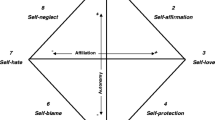Abstract
Purpose
Possible selves are conceptions of our selves in future states. Previous findings indicated that women with anorexia nervosa tended to have more negative possible selves than a control group, even when rating future situations normally regarded in our society as desirable. The present study investigated whether this was a general pattern in women with eating disorders, relating findings on possible selves to depression. Possible selves concerning treatment were also included.
Methods
Patients with anorexia nervosa (n = 19), bulimia nervosa (n = 29) or an eating disorder not otherwise specified (EDNOS) (n = 18) and a control group (n = 27) rated the valence of five possible selves on Likert’s scales. Levels of depression were measured among the patients using the Beck Depression Inventory.
Results
The patients rated the valence of the possible selves significantly less positively and more negatively than did the control group. A strong correlation between valence and depression was found in patients with anorexia nervosa and bulimia nervosa. No such correlation was found in patients with EDNOS. Possible selves concerning future treatment were rated even more negatively.
Conclusions
The results indicate that, when compared to a non-patient group, eating disorder patients make more negative evaluations of possible selves usually seen as desirable. Depression may be a mediating factor in these evaluations for the anorexia and bulimia patients.
Similar content being viewed by others
References
Stein KF, Corte C (2007) Identity impairments and the eating disorders: content and organization of the self-concept in women with anorexia nervosa and bulimia nervosa. Eur Eat Disord Rev 15:58–69
Markus HR (1977) Self-schemata and processing information about the self. J Pers Soc Psychol 35:63–78
Markus HR (1990) Unresolved issues of self-representation. Cogni Ther Res 14:241–253
Knox M (2005) Possible selves and gender. In: Kerpelman J, Dunckel C (eds) Possible selves: theory, research and application. Nova Science Publications, New York, pp 61–77
Markus H, Hamill R, Sentis K (1987) Thinking fat: self-schemas for body weight and the processing of weight relevant information. J Appl Soc Psychol 17:50–71
Erikson MG, Hansson B, Lundblad S (2012) The possible selves of adult women with anorexia nervosa. Eat Disord 20:288–299
Markus HR, Nurius P (1986) Possible selves. Am Psychol 41:954–959
Erikson MG (2007) Towards a more specific definition of possible selves. Rev Gen Psychol 11:348–358
Markus HR, Ruvolo A (1989) Possible selves: personalized representations of goals. In: Pervin LA (ed) Goal concepts in personality and social psychology. Erlbaum, Hillsdale, pp 211–241
Nurius P (1991) Possible selves and social support: social cognitive resources for coping and striving. In: Howard J, Callero P (eds) The self-society dynamic: cognitive, emotion, and action. Cambridge Press, London, pp 239–258
Godley J, Tchanturia K, MacLeod A, Schmidt U (2001) Future-directed thinking in eating disorders. Br J Clin Psychol 40:281–296
Fairburn CG, Bohn K (2005) Eating disorder NOS (EDNOS): an example of the troublesome ‘‘not otherwise specified’’ (NOS) category in DSM-IV. Behav Res Ther 43:691–701
Thomas JJ, Vartanian LR, Brownell KD (2009) The relationship between eating disorder not otherwise specified (EDNOS) and officially recognized eating disorders: meta-analysis and implications for DSM. Psychol Bull 135:407–433
Turner H, Bryant-Waugh R, Peveler R (2010) The clinical features of EDNOS: relationship to mood, health status and general functioning. Eat Behav 11:127–130
American Psychiatric Association (1994) Diagnostic and statistical manual of mental disorders––DSM-IV, 4th edn. Author, Washington, DC
Moor S, Vartanian LR, Touyz SW, Beumont PJV (2004) Psychopathology of EDNOS patients: to whom do they compare? Clin Psychol 8:70–75
Bjärehed J, Sarkohi A, Andersson G (2010) Less positive or more negative? future-directed thinking in mild to moderate depression. Cogn Behav Ther 39:37–45
MacLeod AK, Byrne A (1996) Anxiety, depression and the anticipation of future positive and negative experiences. J Abnorm Psychol 105:286–289
MacLeod AK, Byrne A, Valentine JD (1996) Affect, emotional disorder and future- directed thinking. Cogn Emot 10:69–86
MacLeod AK, Salaminiou E (2001) Reduced positive future-thinking in depression: cognitive and affective factors. Cogn Emot 15:99–107
Beck AT, Rush J, Shaw B, Emery G (1979) Cognitive theory of depression. Guilford Press, New York
Beck AT, Steer RA, Garbin MG (1988) Psychometric properties of the Beck Depression Inventory: twenty-five years of evaluation. Clin Psychol Rev 8:77–100
Allen LA, Woolfolk RL, Gara MA, Apter JT (1996) Possible selves in major depression. J Nerv Ment Dis 184:739–745
Bruch H (1974) Eating disorders: obesity, anorexia nervosa and the person within. Routledge Kegan Paul, London
Favaro A, Santonastaso P (2002) The spectrum of self-injurious behavior in eating disorders. Eat Disord 10:215–225
Penland EA, Masten WG, Zelhart P, Fournet GP, Callahan TA (2000) Possible selves, depression and coping skills in university students. Pers Individ Differ 29:963–969
Erikson MG (2006) Our selves in the future [diss]. Department of psychology, Lund university, Lund
Kennedy SH, Garfinkel PE (1992) Advances in diagnosis and treatment of anorexia nervosa and bulimia nervosa. Can J Psychiatr 37:309–315
Strober M (2004) Managing the chronic, treatment-resistant patient with anorexia nervosa. Int J Eat Disord 36:245–255
Conflict of interest
On behalf of all authors, the corresponding author states that there is no conflict of interest.
Author information
Authors and Affiliations
Corresponding author
Additional information
PsycINFO classification: 3260 Eating Disorders.
Rights and permissions
About this article
Cite this article
Erikson, M.G., Hansson, B. & Lundblad, S. Desirable possible selves and depression in adult women with eating disorders. Eat Weight Disord 19, 145–151 (2014). https://doi.org/10.1007/s40519-014-0122-7
Received:
Accepted:
Published:
Issue Date:
DOI: https://doi.org/10.1007/s40519-014-0122-7




